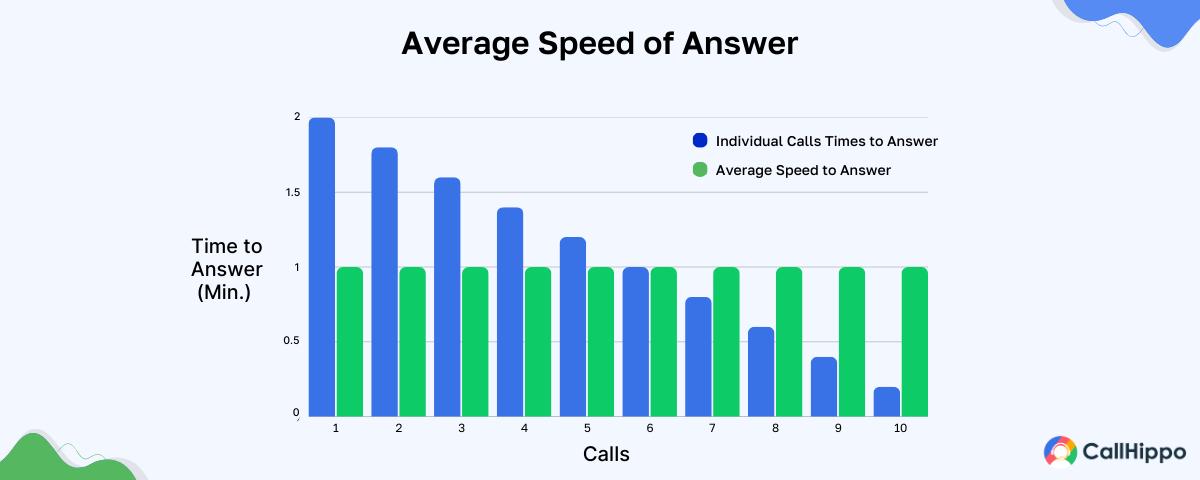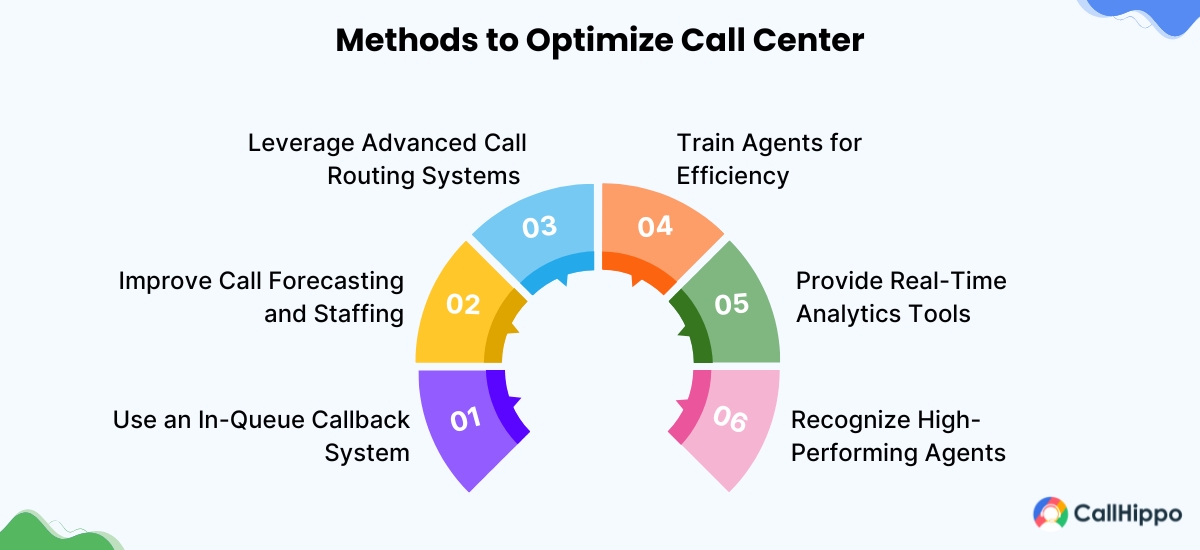Missed customer calls can lead to lost revenue and a weaker brand reputation. That’s why tracking ASA (Average Speed of Answer) is essential. It tracks how fast agents answer calls, which affects both customer satisfaction and how smoothly things run.
In this blog, we will understand what ASA means and why it matters. We will also share practical ways to improve it, boosting your business communications and customer experience.
Improving ASA is key to delivering exceptional customer service. Optimize call routing, staffing, and training to ensure quicker responses. It will enhance customer satisfaction and drive higher operational efficiency.
What is the Average Speed of Answer (ASA) in Call Centers?
ASA tracks the average time it takes for a call center to answer an incoming call. It’s an essential performance indicator (KPI) that helps businesses measure their customer service.

ASA is measured by dividing the total wait time for all calls by the number of calls answered in a set time frame.
Why is Average Speed of Answer Important?
The Average Speed of Answer (ASA) plays an important role in tracking the customer experience. When a call is answered promptly, customers feel prioritized, leading to a more positive interaction.

However, when wait times are long, customers may hang up or share negative feedback. This can impact your brand’s reputation and cause customers to seek alternatives. Here are the key points are as follows:
1. Positive Impact on Customer Satisfaction
When a call is answered quickly by a customer service representative, customers feel valued and are more likely to have a positive experience. Long wait times can lead to causing customers to hang up their calls or leave negative feedback.
2. Consequences of Poor ASA
When ASA is high, the consequences can be severe. Not only do customers feel disappointed, but they may also leave, resulting in lost business. Additionally, a poor ASA can lead to a drop in customer retention and lower overall revenue.
3. ASA’s Role in Service-Level Agreements (SLAs)
Many businesses include ASA in their SLAs to make sure customers get quick responses. Meeting these targets helps maintain service quality and keeps customers delighted.
How to Calculate ASA in Call Centers?
Calculating ASA in call centers is straightforward and involves a simple formula. ASA measures the average time it takes for an agent to answer a call once it’s received. By calculating this metric, you can get a clear understanding of your contact center’s efficiency and responsiveness. Here’s how to calculate it:
- Total Wait Time for All Calls / Number of Calls Answered
- For example, if a call center answered 100 calls and the total wait time was 5,000 seconds, the ASA would be:
ASA = 5,000 / 100 = 50 seconds
This means, on average speed, it took 50 seconds to answer each call.
What Is a Good ASA for a Call Center?
A good ASA depends on call center industry standards and the complexity of the calls being handled. Generally, a shorter ASA is better, but it’s essential to find a balance between speed and service quality.
Here’s what you need to know:
Industry Benchmarks and Standards for ASA
While a “good” ASA depends on the type of contact center, many call centers aim for a response time of (20-30 seconds) for inquiries. In more specialized sectors, like technical support, a slightly higher ASA (around 60 seconds) might be acceptable.
Here’s a breakdown of ASA targets across industries:
- Retail/E-commerce: 20-30 seconds
- Healthcare: 30-60 seconds
- Financial Services: 30-45 seconds
Several elements can influence interactive voice response in ASA, including:
- Call Volume: Higher call volume typically leads to longer wait times.
- Call Complexity: More complicated calls take longer to resolve, which can impact the call center’s average speed.
- Staffing Levels: If there aren’t enough customer service representatives, ASA will likely increase.
How to Optimize and Improve Your Call Center’s ASA?
Improving ASA isn’t just about answering calls faster, it’s about optimizing your entire workflow. Here are six strategies for automatic call distribution and improving your call center’s efficiency:

1. Use an In-Queue Callback System
Instead of waiting on hold, customers can opt for a callback when an agent is available. This approach allows customers to resume their activities without interruption, creating a hassle-free experience.
2. Improve Call Forecasting and Staffing
By predicting high-traffic periods and adjusting staffing accordingly, businesses can prevent long wait times for customers. Analyzing past data helps identify peak hours, allowing for better experience during busy times.
3. Leverage Advanced Call Routing Systems
Advanced call routing refers customers to the right agent based on their past interactions or expertise. It minimizes transfer time and ensures customers are quickly connected, improving the overall experience.
4. Train Agents for Efficiency
Empowering agents with the right skills helps customers to resolve issues quickly. Ongoing training enables agents to handle various inquiries, reducing the need for call escalation. Regular updates on tools and best practices ensure they’re always ready to handle any situation efficiently.
5. Provide Real-Time Analytics Tools
Providing agents with real-time data allows them to address issues without unnecessary delays. With instant access to customer history and past interactions, agents can offer quick and accurate solutions.
6. Recognize High-Performing Agents
Recognizing and rewarding top performers helps create a culture of excellence and motivates employees to keep improving. It encourages agents to maintain high standards and consistently deliver excellent service.
How ASA Impacts Other Call Center Metrics?
ASA (Average Speed of Answer) plays a crucial role in shaping other call center metrics and overall performance. A quick ASA can lead to better outcomes in areas like customer satisfaction and first-call resolution. Here’s how:
1. Correlation Between ASA and First Call Resolution (FCR)
ASA and FCR are closely related. A low ASA usually leads to a higher FCR since customers don’t have to wait long for help. It means agents can resolve issues faster, leading to greater customer satisfaction.
2. ASA’s Effect on Overall Customer Experience
A low ASA can significantly improve the customer experience. When customers aren’t left waiting, they feel valued and are more likely to stay loyal. On the contrary, poor ASA leads to frustration and higher customer churn.
Example Of Companies Improving ASA Score
Improving ASA requires a targeted strategy that addresses specific challenges in your call center. Let’s dive into a practical example to see how this can be achieved.
Scenario: A small call center handling 3,000 daily calls faced a high ASA of 60 seconds. This caused customer dissatisfaction and complaints about long wait times. Here’s how they turned things around:
1. Optimized Call Routing
They implemented an intelligent call routing system that directed calls to the most experienced agents, ensuring quicker resolutions.
2. Improved Staffing Schedules
By analyzing call patterns, they adjusted staffing during peak hours to reduce wait times.
3. Enhanced Agent Training
Agents received focused training to handle calls efficiently while maintaining quality service.
4. Added a Self-service Option
Customers were given self-service options for simple queries, reducing the overall call volume.
5. Introduced a Callback System
Customers could opt for a callback, minimizing frustration from long hold times.
Result- Within two months, the call center successfully lowered its ASA to 25 seconds. This change increased customer satisfaction by 40% and significantly improved team productivity.
Final Words
Improving your call center’s ASA is key to delivering great service and keeping customers happy. By optimizing staffing, call routing, and analytics, you can cut wait times and enhance service quality. Start implementing these strategies today to boost efficiency and customer satisfaction.
FAQs
1. How can VoIP help improve ASA?
VoIP can improve ASA by providing clearer connections and faster call routing, reducing wait times. It also offers features like automated call distribution, which helps direct calls to the right agents.
2. Does ASA include abandoned calls in its calculation?
Yes, ASA typically includes abandoned calls in its calculation. Calls that are abandoned before being answered are factored into the overall average. This can impact the metric and reflect delays or issues in call handling.
3. What role does AI play in improving ASA?
AI can help improve ASA by enabling smarter call routing and providing real-time insights to agents. It can predict call volumes, automate responses for common inquiries, and assist agents with quick access to customer data.

Subscribe to our newsletter & never miss our latest news and promotions.









